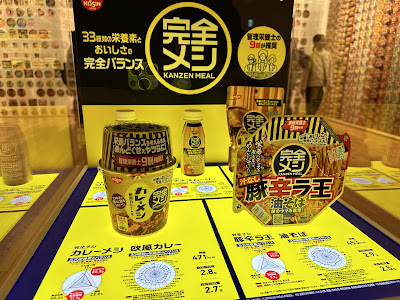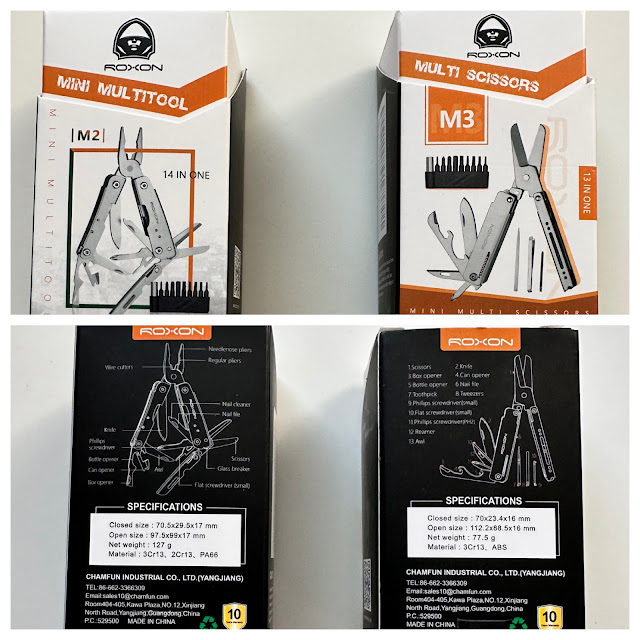I learned about these new Kanzen or Complete meals from Nissin Japan late in the summer of 2022. Naturally, these things don't ever show up in North America so it was one of the things I was looking to try when I was in Japan. There were two varieties of these meals, and some accompanying beverages that reminded me a bit of those meal replacement drinks like Boost. The two meal varieties were an instant curry rice and a Nission RAOH-type instant noodle dish. I picked up the curry rice meal as I already had plenty of instant noodles to try and I do like their curry rice too. The healthier RAOH instant noodles reminded me a about the healthier VITE Instant Ramen from the United States.

Curry Meshi (Meal) is a popular dish in Japan as a home cooked
comfort food or eating out in a restaurant. There are many curry restaurants in Japan and having a tonkatsu curry out is really yummy. Nissin adapted the curry flavour first to Curry Cup Noodles and then to Curry Cup
Instant Rice. The Curry Cup Noodle is one of the more popular brands of
Cup Noodle too, and the instant curry rice has also done well. This
Kanzen Curry Rice builds on this so it isn't just delicious carbohydrates. The
Nissin food scientists "perfected" an ideal balance of 33 types of
nutrients in this instant curry rice!
 |
Kanzen Curry Rice seems to be a bit of hit product.
|
The origins of curry in Japan can be traced back to the Meiji era (1868-1912), when the country was going through a period of modernization and Westernization. During this time, the Japanese military began incorporating curry powder into their rations, which they had acquired from their contact with British and Indian soldiers. This exposure to curry sparked a fascination among the Japanese people, who began experimenting with the spice blend in their own cooking. Curry was soon introduced to the general public through cafes and restaurants, and it quickly became a popular and affordable meal option.
During World War II, curry became even more widespread as the government encouraged its consumption as a nutritious and filling meal for soldiers and civilians alike. This led to the creation of "curry rice," a dish that remains a staple of Japanese cuisine to this day. In the post-war years, Japan experienced an economic boom that led to an increase in international travel and exposure to new cuisines. This exposure led to the development of new styles of curry in Japan, such as "katsu curry" (curry served with breaded and fried pork or chicken) and "Japanese-style curry," which is sweeter and less spicy than traditional Indian curry.
Japanese curry is now found in almost every corner of Japan, being an integral part of Japanese culture and a beloved comfort food that is often served with pickled vegetables and rice. In recent years, there has been a growing interest in the history and cultural significance of curry in Japan. This has led to the establishment of museums and festivals dedicated to the dish, as well as a renewed interest in traditional curry recipes and cooking techniques. The story of curry in Japan is a fascinating example of how a foreign cuisine can become integrated into a nation's culinary culture, and how it can evolve and adapt over time to become a beloved and iconic dish.
The Nissin Kanzen Instant Curry Rice Cup is ready to eat in five minutes after adding boiling water, plus a bit of final mixing time for the curry powder and ingredients. The company says you get a perfectly balanced curry that is both nutritious and delicious in every cup. They used their state of the art food science to make the bitterness and harshness peculiar to some nutrients fade into the tastiness of the curry. Spices such as coriander and cardamom add to the rich flavor, sweetness
comes from onions, and it is a European-style (savoury beef stew-like) curry finished with chili
peppers. Due to this, the taste of their regular Curry Meshi Cup, which this is based on, is maintained. This curry rice has the three major nutrients of protein, fat, and carbohydrates with the addition of vitamins, minerals, and essential fatty acids.
I don't usually go into depth about the nutritional information for instant noodles or rice, but it seems appropriate to do so for this product. Each serving of 119g contains 471kcal. There are 20.9g protein, 12.4g fat, 74.4g carbs (dietary fiber 11.1g), and 2.7g salt. Each serving also contains vitamins A, D, E, K, B1, B2, C, B6, and B12, along with saturated fatty acids, n-3 fatty acid, n-6 fatty acid, folic acid, pantothenic acid, biotin, niacin, potassium, calcium, magnesium, phosphorus, iron, zinc, copper, manganese, iodine, selenium, chromium, and molybdenum. These nutrients are in proportion based on “Dietary Reference Intakes for Japanese People” (2020 edition).
 |
The front of the Kanzen Curry Rice Cup. It has a unique topper that advertises all of the benefits of this meal and stores the additional powdered nutrient and curry sauce packets.
|
 |
Three quarters views of the cup. You can see the yellow and blue striping and bold Kanzen Meal characters on the topper. It is very distinctive and hard to miss on a shelf. The topper is made of transparent plastic with a printed cardboard liner inside. The characters basically say "Are you thinking about balanced nutrition? 90% of dieticians recommend...etc."
|
 |
More slogans on the back of the topper.
|
 |
Once you take the topper off you get a normal cup. It has the regular Nissin Cup Rice branding and logos in blue on yellow. The difference is the big circular Kanzen Meal logo to the right.
|
 |
Front of the cup. Shows thick, dark, European style curry below the Cup Rice logo and Kanzen Meal logo.
|
 |
Preparation directions, nutritional information, allegens, and balanced meal information. Some of the text talks about an adult male with normal physical activity requiring 2700 kcals in a day. These cups are pretty dense in information.
|
 |
Ingredients and manufacturers information.
|
 |
Detailed preparation instructions on the lid.
|
 |
Some Google Translate of the Japanese shown above.
|
Usually the curry powder is mixed in with the rice, but for the Kanzen Meal, it is actually a separate powder pouch (custom formulation) and a flavour oil packet. These were stored under the topper.
 |
Powdered curry sauce base along with nutrients and a separate flavour oil packet shown above.
|
 |
Under the lid, you see freeze-dried rice, mystery meat cubes, freeze-dried potatoes.
|
 |
You add boiling water up to the fill line and then these bubbles form. The packaging even says that bubbling is perfectly normal. Not sure what kind of reaction is happening.
|
 |
After 5 minutes, the rice is rehydrated. You then add in the curry powder and the oil packet. There is still plenty of water in the cup and and you now must mix it all really well together to finish up.
|
 |
The final product looks like this. It looks just like a regular curry cup rice.
|
I had a pretty keen interest in trying this Kanzen Meal out. There was actually a mild meaty smell from the meat cubes and rice as they were rehydrating. The rice made lots of bubbles as it rehydrated, which is always kind of interesting as you are wondering about what kind of reaction is happening. There is no chemical smell or anything, just the smell of rice and meat. After it rehydrated for 5 minutes I added in the curry powder and the flavouring oil. It completely covered up the rice as there was a lot of powder. I had to vigorously stir the rice to make sure all of the powder was mixed in. At this point there were curry and slightly spicy beef aromas coming from the the cup. It smelled pretty good. Definitely tasty and not like a balanced meal packed full of nutrients. The flavour was that of their regular beef curry, but with a slightly higher heat that you could feel on the tongue. It was a tasty beef curry with a meaty umami to it. The rice was soft and firm, not crunchy and it went well with the curry. The meat cubes were a very nice touch along with the little pieces of potato. I could easily have this again and would get another one the next time I visit Japan. Maybe I'll try the noodle one next time though. If you were preparing some emergency rations, these would be a good choice. You would just need to ensure you rotate these out before their expiry dates. Part of Japanese emergency food planning is to have shelf-stable foods that you would eat normally to help with the rotation. This Kanzen Meal easily fits that description!
 |
Closeup of the curry sauce, rice, and a cube of meat.
|
Some Other Gear Posts
Follow me on Twitter or Instagram at @Tostzilla or my feedburner.
More snacks, ramen and Japanese pop culture.




























Comments
Post a Comment